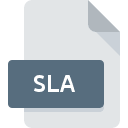.SLA File Extension

Scribus Document
| Developer | Scribus |
| Popularity | |
| Category | Text Files |
| Format | .SLA |
| Cross Platform | Update Soon |
What is an SLA file?
.SLE files are associated with Sisulizer, a localization and translation software used by developers and businesses to adapt their software applications into different languages. These files play a crucial role in the localization process, storing project-related information, including the source text, translations, and various settings.
More Information.
The history of .SLE files is tied to the development of Sisulizer, which was created to streamline the localization process for software developers. The initial purpose was to provide a comprehensive solution for managing translation projects, ensuring that applications could easily adapt to diverse linguistic environments.
Origin Of This File.
The .SLE file extension is specific to Sisulizer, and it originates from the need for a structured format to save and manage translation projects efficiently. Sisulizer simplifies the translation workflow by providing a centralized platform for managing multilingual projects, and .SLE files are an integral part of this system.
File Structure Technical Specification.
.SLE files are typically structured as project files, containing metadata, source texts, and translations. The technical specifications may include information about the source code, language codes, and other project-specific settings. The format may be proprietary to Sisulizer, requiring the Sisulizer software to interpret and utilize the data within.
How to Convert the File?
Windows:
- Open Sisulizer on your Windows system.
- Load the .SLE file by either double-clicking on it or using the “Open” option within the Sisulizer interface.
- Once the project is loaded, navigate to the export or save options within Sisulizer.
- Choose the desired output format for conversion, such as .resx or .po.
- Follow the on-screen instructions to complete the conversion process.
- The converted file can now be used in other localization tools or platforms as needed.
Linux:
- Install WINE or a similar compatibility layer on your Linux system.
- Use WINE to run the Sisulizer software.
- Open the Sisulizer application within WINE.
- Load the .SLE file through the Sisulizer interface.
- Navigate to the export or save options within Sisulizer.
- Choose the desired output format for conversion.
- Follow the on-screen instructions to complete the conversion.
- The converted file can now be utilized in other localization tools on Linux.
Mac:
- Use a Windows emulator or virtual machine on your Mac with Sisulizer installed.
- Start the virtual environment and open the Sisulizer application.
- Load the .SLE file using the Sisulizer interface.
- Access the export or save options within Sisulizer.
- Select the desired output format for conversion.
- Follow the on-screen instructions to finish the conversion process.
- The converted file is now ready for use in other localization tools on your Mac.
Android:
- Export the translations from Sisulizer in a format compatible with Android, such as XML or strings resource files.
- Place the exported files in the appropriate directories within your Android project.
- Integrate the translations into your Android application code.
- Recompile and build your Android application to incorporate the converted translations.
- Test the application on an Android device or emulator to ensure proper localization.
iOS:
- Export translations from Sisulizer in a format compatible with iOS, such as .strings files.
- Add the exported files to the localized resource folders within your Xcode project.
- Configure your iOS project to use the localized files for the desired languages.
- Build and run your iOS application using Xcode to see the converted translations in action.
- Verify the localization on an iOS device or simulator.
Advantages And Disadvantages.
Advantages:
- Centralized management of translation projects.
- Efficient handling of multilingual resources.
- Simplifies collaboration among translators.
- Enables easy updates and modifications to translations.
Disadvantages:
- Dependency on Sisulizer software for full functionality.
- Limited interoperability with other localization tools.
- Potential issues if not used properly, leading to project inconsistencies.
How to Open SLA?
Open In Windows
- Ensure Sisulizer software is installed.
- Double-click the .SLE file, or open it through the Sisulizer interface.
Open In Linux
- Use WINE or a similar compatibility layer to run Sisulizer.
- Open the .SLE file through the Sisulizer software.
Open In MAC
- Use a Windows emulator or virtual machine with Sisulizer installed.
- Open the .SLE file within the Sisulizer environment.
Open In Android
- Since Sisulizer is primarily a Windows application, exporting translations to platform-specific formats may be necessary.
- Utilize the exported files in the respective localization frameworks or tools for each platform.
Open In IOS
- Since Sisulizer is primarily a Windows application, exporting translations to platform-specific formats may be necessary.
- Utilize the exported files in the respective localization frameworks or tools for each platform.
Open in Others
- Since Sisulizer is primarily a Windows application, exporting translations to platform-specific formats may be necessary.
- Utilize the exported files in the respective localization frameworks or tools for each platform.













